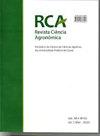Estimation of water erosion rates in Espírito Santo state, Brazil
IF 0.7
4区 农林科学
Q3 AGRICULTURE, MULTIDISCIPLINARY
引用次数: 0
Abstract
- Water erosion is a natural geological process that is common in tropical regions. It is important to monitor it to contain its physical, environmental, and socio-economic impacts. In the Espírito Santo state, Brazil, much of the land is used for agriculture and studies related to water erosion are scarce. The spatial modeling of water erosion is useful for proposing mitigating measures because combining it with data from geographic information systems can identify the areas most prone to soil loss. The Revised Universal Soil Loss Equation - RUSLE, is a model that requires little input data and is easy to use, providing results useful of helping to mitigate water erosion and promote sustainable land use planning. This study estimates the water erosion rates in the Espírito Santo state by RUSLE and compares them with the soil loss tolerance (T) limits. The parameters used in the model are the land use and management, the soil attributes, the relief and the climate factors. Approximately 38.65% of the state’s area shows soil loss above the T limit (7.79 - 14.14 Mg ha -1 year -1 ). The areas with steeper slopes and low vegetation cover have most of the highest erosion rates. The mean annual soil loss of the entire state is 33.55 Mg ha -1 year -1 . RUSLE provided a diagnosis useful of directing erosion mitigation measures to the most susceptible areas, enabling sustainable planning to support the state’s socio-economic development.巴西圣托州Espírito水侵蚀率的估算
-水侵蚀是热带地区常见的自然地质过程。重要的是对其进行监测,以控制其对自然、环境和社会经济的影响。在巴西的Espírito圣州,大部分土地用于农业,与水土流失有关的研究很少。水土流失的空间模拟有助于提出缓解措施,因为它与地理信息系统的数据相结合,可以确定最容易发生土壤流失的地区。修订的通用土壤流失方程(RUSLE)是一个需要很少输入数据且易于使用的模型,其结果有助于减轻水土流失和促进可持续土地利用规划。本文利用RUSLE估算了Espírito桑托州的水土流失速率,并与土壤容失量(T)限值进行了比较。模型参数包括土地利用与管理、土壤属性、地形起伏和气候因子。该州约38.65%的地区土壤流失超过T限值(7.79 - 14.14毫克/公顷-1年-1年)。坡度较陡、植被覆盖率低的地区侵蚀速率最高。全州年平均土壤流失量为33.55 Mg ha -1年-1。RUSLE提供了一种诊断,有助于将减少侵蚀的措施定向到最易受影响的地区,从而实现可持续规划,支持国家的社会经济发展。
本文章由计算机程序翻译,如有差异,请以英文原文为准。
求助全文
约1分钟内获得全文
求助全文
来源期刊

Revista Ciencia Agronomica
Agricultural and Biological Sciences-Horticulture
CiteScore
2.00
自引率
0.00%
发文量
41
审稿时长
4-8 weeks
期刊介绍:
To publish technical-scientific articles and study cases (original projects) that are not submitted to other journals, involving new researches and technologies in fields related to Agrarian Sciences. Articles concerning routine analysis, preliminary studies, technical notes and those which merely report laboratorial analysis employing traditional methodology will not be accepted for publication. The Journal of Agronomical Science also has the mission to promote the exchange of experience in the referred fields.
 求助内容:
求助内容: 应助结果提醒方式:
应助结果提醒方式:


